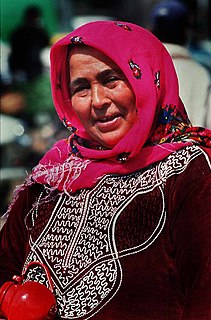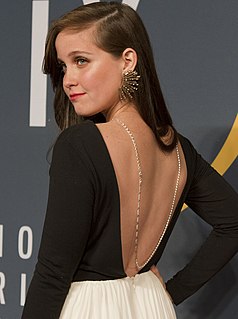
A hijab is a veil worn by certain Muslim women in the presence of any male outside of their immediate family or sometimes by men, which covers the head and chest. Another interpretation can also refer to the seclusion of women from men in the public sphere, whereas a metaphysical dimension, may refer to "the veil which separates man, or the world, from God".

Dame Mary Louise Webster,, known professionally as May Whitty and later, for her charity work, Dame May Whitty, was an English stage and film actress. She was one of the first two women entertainers to become a Dame. The British actors' union Equity was established in her home. After a successful career she moved over to Hollywood films at the age of 72. She went to live in the United States, where she remained for the remainder of her life, appearing in films.

Colin Clive was a British stage and screen actor. His most memorable role was Henry Frankenstein, the creator of the monster, in the 1931 film Frankenstein and its 1935 sequel, Bride of Frankenstein.

A niqāb or niqaab, also called a ruband, is a garment that covers the face, worn by some Muslim women as a part of an interpretation of hijab. The terms niqab and burqa are often confused; a niqab covers the face while leaving the eyes uncovered, while a burqa covers the entire body from the top of the head to the ground, with only a mesh screen allowing the wearer to see in front of her. According to the majority of Muslim scholars and Islamic schools of thought, face veiling is not a requirement of Islam; however a minority of Muslim scholars, particularly among the Sunni Salafi and Wahhabism movement, assert that women are required to cover their faces in public. Those Muslim women who wear the niqab, do so in places where they may encounter non-mahram (un-related) men.

Una O'Connor was an Irish-American actress who worked extensively in theatre before becoming a character actress in film and in television. She often portrayed comical wives, housekeepers and servants. In 2020, she was listed at number 19 on The Irish Times' list of Ireland's greatest film actors.

A crop top is a top that exposes the waist, navel, or abdomen.

Figueirense Futebol Clube, commonly referred to as Figueirense, is a Brazilian professional club based in Florianópolis, Santa Catarina founded on 12 June 1921.

The Crown of Queen Elizabeth The Queen Mother, also known as The Queen Mother's Crown, is the crown made for Queen Elizabeth, the wife of King George VI, to wear at their coronation in 1937 and State Openings of Parliament during her husband's reign. The crown was made by Garrard & Co., the Crown Jeweller at the time, and is modelled partly on the design of the Crown of Queen Mary, though it differs by having four half-arches instead of eight. As with Queen Mary's Crown, its arches are detachable at the crosses pattée, allowing it to be worn as a circlet or open crown. It is the only crown for a British king or queen to be made of platinum.

A waist bag, or fanny pack (US), belt bag, moon bag, belly bag, or bumbag is a small fabric pouch worn like a belt around the waist by use of a strap above the hips that is secured usually with some sort of buckle. The straps sometimes have tri-glide slides, making them adjustable in order to fit properly. It can be considered as a purse worn around the waist.
"The Wearing of the Green" is an Irish street ballad lamenting the repression of supporters of the Irish Rebellion of 1798. It is to an old Irish air, and many versions of the lyric exist, the best-known being by Dion Boucicault. The song proclaims that "they are hanging men and women for the wearing of the green".

The caubeen is an Irish beret, formerly worn by peasants. It has been adopted as the head dress of Irish regiments of Commonwealth armies.
The Governor-General of Australia has, at irregular intervals, notified for general information the positioning of the wearing of Australian Orders, Decorations and Medals in the Commonwealth of Australia Gazette. The Order of Wearing Australian Honours and Awards was last published in 2007, and replaced the previous list published in 2002.

A backless dress is a style of women’s clothing designed to expose the wearer's back. The back may be either partially exposed with a low cut or fully exposed with the use of strings. A backless dress is most commonly worn on formal occasions or as evening wear or as wedding dresses and can be of any length, from a miniskirt-length to floor-length. Other backless styles include backless swimsuits and tops, such as a haltertop.

Trousers, slacks, or pants are an item of clothing that might have originated in Central Asia, worn from the waist to the ankles, covering both legs separately.

General Artemas Ward is a bronze statue of American Revolutionary War general Artemas Ward by Leonard Crunelle at Ward Circle, at the intersection of Nebraska and Massachusetts Avenues in Northwest, Washington, D.C.

Dangerous Number is a 1937 American comedy film directed by Richard Thorpe and written by Carey Wilson. The film stars Robert Young, Ann Sothern, Reginald Owen, and Cora Witherspoon, and features Dean Jagger. The film was released on January 22, 1937, by Metro-Goldwyn-Mayer.

September in the Rain is a 1937 Warner Bros. Merrie Melodies cartoon directed by Friz Freleng. The short was released on December 18, 1937.

The Fondukistan monastery was a Buddhist monastery located at the very top of a conical hill next to the Ghorband Valley, Parwan Province, about 117 kilometers northeast of Kabul. The monastery dates to the early 8th century CE, with a terminus post quem in 689 CE obtained through numismatic evidence, so that the Buddhist art of the site has been estimated to around 700 CE. This is the only secure date for this artistic period in the Hindu Kush, and it serves as an important chronological reference point.

The lobster dress is a 1937 dress designed by Elsa Schiaparelli. It features a large lobster painted by Salvador Dalí.

















